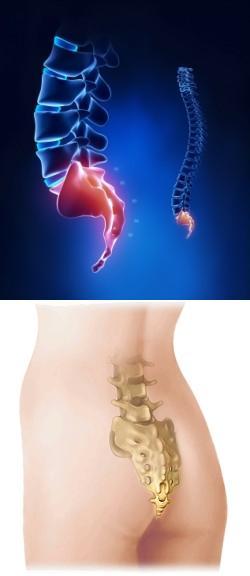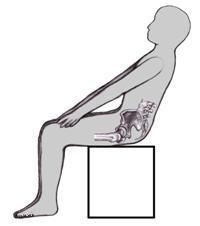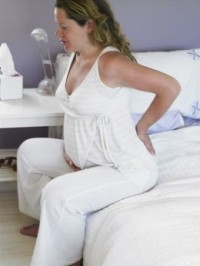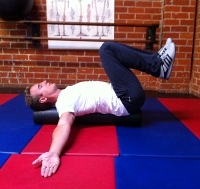The coccyx is called the bottom of the spine formed by the underdeveloped 4-5 vertebrae fused. Once these vertebrae supports the tail in human ancestors, and that now is the coccyx is vestigial, useless organ. However, this vestige of injuries and various diseases that can cause a person serious pain and discomfort: you can not properly sit and walk, even sleep is hard to find a comfortable position.
Often the patient, even by himself cannot determine the precise localization of pain and complains to the doctor for pain in the tailbone (this pain is called anorectal). The pain in the coccyx is, in fact, called coccyalgia.

Experts will have to decide if the pain of illnesses and injuries to the coccyx itself, or pain from other organs (intestines, pelvis, urinary organs) and simply "give" in the coccyx. On the basis of the solution of this question depends on the treatment.
Causes of pain in the coccyx
- The consequences of the injury.
- Diseases of the spine that affect the coccyx (lower back pain, displacement of the intervertebral discs pinching the nerve endings, etc.).
- Diseases of the muscles and nerves of the pelvic floor.
- Pathology of the processes of the pelvis.
- Disease direct or sigmoid colon (hemorrhoids, sigmoid, proctitis, rectal fissure).
- The omission of the perineum (for example, because of the difficult birth).
- The Trauma of the perineum during childbirth (bleeding in the subcutaneous tissue surrounding the coccyx).
- Excessive extension of the coccyx for difficult births.
- Cicatricial deformations of the anus, that arise as a complication of the surgery.
- Disorders of the intestine, causing frequent constipation or diarrhea, and, therefore, the habit of sitting for long periods of time on the radio.
- Diseases of the genitourinary system (cystitis, adnexitis, etc.).
- A cyst of the coccyx.
- The habit of constantly sitting in upholstered furniture.
- Emotional turmoil and stress.
- Tight clothing (jeans), putting pressure on the coccyx.
- Idiopathic pain (pain of unknown origin). This type of pain, may suddenly appear and suddenly disappear. Approximately 1/3 of all the pain in the coccyx is referred to as idiopathic.
Characteristics of pain in the coccyx in different diseases
Pain after the injury
Trauma often causes severe, acute, acute pain in the coccyx. Injury of the coccyx (rupture, fracture, confusion, dislocation, displacement) may occur when a bad fall or blow to the buttocks. Pain after injury can be in the nature of the attacks, or be constant. When walking and in a sitting position increases. The localization of various post-traumatic pain in the coccyx, or near it (above, below, side).
Usually the pain in the coccyx occur immediately after the injury. But in some cases can be slightly expressed and quickly passing, and a few years later, when the patient forgot about the injury, suddenly, there appears a strong burning pain.
Pain in the coccyx, combined with pain in the low back, sacrum
In osteochondrosis, the cyst of the spine in the lumbar or sacral division is characterized by a combination of pain in the coccyx with back pain in the sacrum. However, the main complaints of the patient with pain in the back, and along the way – that the pain "gives" in the coccyx.
The same clinical picture observed in the pinching the nerve endings in the lumbar and sacral parts of the spine. The compression of the sciatic nerve (sciatica) is accompanied by burning, sharp pain in the tailbone or above it.
Lumbar and sacral pains accompanied by pain in the coccyx also hemorrhoids, diseases of the rectum.
Pain in the coccyx when you stand up
This type of pain is it strange that the lesions of the coccyx. More frequently associated with postoperative scars in the perineum, or adhesions in the pelvic cavity, formed after the operation.
Pain in the tailbone when leaning
Pain in bending are usually the result of inflammatory processes chronic in organs located near the coccyx (in the intestine or the bladder, the uterus and its annexes).
Pain in the coccyx when the inclination occur when the patient has the following diseases:
- dysbiosis;
- colitis;
- sigmoid;
- cystitis;
- adnexitis;
- endometritis etc.
Pain radiating to coccyx
As already mentioned, pain radiating to tailbone, characteristic of osteoarthritis, cysts of the spine, as well as for hemorrhoids, the inflammation in the joints of the hip, diseases of the rectum, etc. This pain can also be caused by the healing of wounds postoperative.
Pain in the coccyx when sitting

The reason for this type of pain is the habit of constantly sitting in upholstered furniture. The coccyx is in the wrong position. In the vessels that supply blood, have stagnation. This leads to the deposition of salts in the vertebrae that constitute the coccyx, and the appearance of pain.
Pain in the coccyx when sitting to complain about athletes, cyclists and persons involved in horse riding. Have cause of pain other: microtrauma of the coccyx, occurs when the participation in these specific activities.
Pain in the coccyx when sitting is possible in women after childbirth, when there was a deformation (excessive flattening of the intervertebral joints).
Finally, the pain in the coccyx, aggravated when sitting, typical dermoid cyst of the coccyx. Dermoid cyst is a congenital malformation, consisting in the formation in the coccyx of cavity, filled by the tissue growth of the hair.
Pain and drawing pain in the coccyx
Pain pain in the coccyx can occur if the inflammation of the internal genital organs (prostatitis or BPH in men with an inflammation of the ovaries and fallopian tubes in women).
Gnawing pain in the coccyx is another symptom of degenerative disc disease of the lumbar or sacral spine. Sometimes occurs when the hemorrhoid and also the time sitting in the radio frequent cause of constipation.
Pain in the coccyx
The pain of this type occur when prolapse of the perineum, with the presence of scars in the anus, diseases of the rectum. It is characterized by pain beneath the coccyx and trauma (fracture, contusion, subluxation' of the tailbone) that happened a few years ago.
Pain about the coccyx
Pain localized over the coccyx, characteristic of neuralgias' (inflammation of the nerves emanating from the lumbar or sacral spine).
Pain in the coccyx during menstruation
This pain can accompany many gynecological and neurological diseases. It may be reasonable to begin the examination with the advice of a gynecologist and only exclude gynecological diseases, to consult a neurologist.
Pain in the tailbone during pregnancy and after delivery
Pregnant women often have pain in the coccyx. Pain in the tailbone during pregnancy can have several causes:
- Trauma to the coccyx, which took place a few years ago and that it is not recovered.
- Lack of calcium in the skeletal system.
- Inflammatory diseases of internal genital organs.
- Physiological changes in the body: when preparing for labour and delivery, the pelvic organs change their normal position. The foetus grows, the uterus increases, the displacement of the bodies nearby. The coccyx, while that reclines. And since the coccyx vertebrae are fused to each other, this deviation is very painful.
Pain in the coccyx after the birth, to say that the experience gynecologist what happened to birth trauma: difficult birth caused bleeding in the soft tissue surrounding the coccyx, or what happened to its excessive straightening (which is possible when large amounts of fruit).
Pain in the coccyx in men
In men, pain in the coccyx can be caused by the so-called "pellentesque disease." This disease occurs with frequent horse unsprung carriage (crawler tractors, army tanks, armored personnel carriers). The load on the coccyx when riding on this type of equipment is excessive. Can cause inflammation of pilonidal sinus or cyst of the coccyx. This movement, or cyst, is a hollow tube that runs beneath the skin from the end of the coccyx and ending blindly.
Inflammation of the pilonidal sinus and is called "pellentesque disease." If the inflammation passes into the purulent stage, often forms a fistula – pus explodes. Treatment is only surgical.

How to treat the pain in the coccyx
A first survey
For an effective treatment of pain in the coccyx, it is important to establish its cause. Patients with this type of pain should appeal, primarily, to the proctologist. This specialist when necessary refer the patient (the patient) to a gynaecologist, neurologist, surgeon, osteopath. Sometimes, requiring the help of a therapist.
Each one of these doctors not only examines the patient but also very detailed question it. The patient has to be willing to talk in detail about the nature of pain, its location, the remembrance of previous trauma and history of surgery.
In some patients with pain in the coccyx, the exact diagnosis cannot be established. Then, apply the treatment is symptomatic, and in the majority of cases, it leads to good results. Sometimes the pain in the tailbone go on its own, without treatment. But the hope is not necessary - if you have this kind of pain that must be to see your doctor.
The main aspects of the treatment
In the majority of cases, the pain in the coccyx is treated conservatively (i.e. without surgery). Comprehensive treatment consists of providing patients with the rest, analgesic, restore the impaired circulation through massage, chiropractic, physical therapy, physical exercise, therapy.
All of the identified comorbidities compulsory treatment.
To eliminate or weaken the negative emotions are applied (after advice) neuropsychotropic drugs.
No help can be given by doctors only when pain in the coccyx in pregnancy. Anti-inflammatory and pain is contraindicated for pregnant women. Radiological diagnosis is also excluded. Therefore, women have to put up with the pain in the coccyx, enclosing under a soft pillow or inflatable rubber circle in the shape of a donut (sold in pharmacies).
To sit in this circle, it is recommended not only to pregnant women, but for all patients with pain of this type of location. This simple device eliminates the burden and pressure on the coccyx while sitting, thus reducing pain.
Chiropractic, massage, acupuncture
Pain in the coccyx greatly facilitated by the use finger massage of the muscles of the rectum and massage the muscles of the pelvic floor (if there is spasm).
The manual therapy techniques performed by experienced professionals, specialist, improve the circulation of blood into the coccyx, removing stasis of blood, relieve muscle spasm and helps restore the range of motion of the coccyx.
Acupuncture (acupuncture) is often used for pain in the coccyx, substantially reducing its intensity. The right of choice of biologically active points of acupuncture can completely remove the pain.
Physical therapy
Of the methods of physiotherapy for pain in the coccyx apply:
- ultrasound treatment;
- laser therapy;
- UHF;
- electrotherapy (electrode inserted in the rectum);
- diadynamic currents;
- darsonval;
- an application with paraffin;
- therapeutic mud;
- the ozokerite.
Physiotherapy
To exercise, perform morning exercises to the person with pain in the coccyx is not only possible, but necessary. With certain limitations: the exercise should be run, jump, walk brisk, sudden inprobus movement, straining.
The years of pain in the coccyx should include the following exercises:
- Lying on your back on the floor, bend your knees and raise them to the face. Put the palms of the hands to the inner side of the knee. Try to join knees, hands at the same time, oppose this movement.The number of repeat 8-12 times with short intervals (10-15 seconds).
- In the same fixed position between the knees bent, the ball (football, volleyball or another of the same size). The palms of your hands put on the belly. With the holding force on the knees of the ball for 5-7 seconds while the palm trees by preventing the exit of the abdomen.The number of repetitions 6-8 times with the same intervals for the rest, as in the first exercise.
- Lying on back, hold ball between feet and straightened her legs. With the holding force of the ball stops for 5-7 seconds. The number of repetitions 6-8 times; the intervals is 10-15 seconds.
- Lying on your back, raise your hand bent at the knees and lift the hips for 3-5 seconds. The gluteal muscles need to strain. The number of repetitions 6-8 times; the intervals is 10-15 seconds.
All the years of pain in the coccyx, the patient needs to run slowly, steadily, rhythmically, resting between repetitions of the exercise. You can turn on a relaxing music. For greater efficiency it is recommended to do a series of exercises twice a day.
Folk remedies

For pain in the coccyx, the traditional medicine uses the following tools:
- The impact of magnet: ring magnet in the movement in the coccyx in a circle, clockwise for 15-20 minutes 2-3 times a day.
- Compress with tincture of Valerian: a piece of cotton cloth to moisten the pharmacy tincture of Valerian, to put in the wrong place. Cover it with a piece of plastic, then any warm layer (wool, scarf, etc.). To fix the compress with adhesive tape and left for the night.
- Fir oil is rubbed on the tailbone 3 times a day. Helps to relieve inflammation and reduces pain.
- The lubrication iodine: at night, before going to sleep, pre-heat the coccyx be lubricated with tincture of iodine and warm wrap. Repeat no more often than 2-3 times per week. Duration of treatment – 1.5-2 months.
- Compresses made of blue clay: add 500 gr. clay a teaspoon of Apple cider vinegar, mix well. Before you go to sleep apply a layer of this mixture to the affected area, cover with polythene, to warm (like any pack) and get out for the night.
- The benefits of radish juice: mix 300 ml of fresh juice of radish, 100 ml of ethanol and 200 ml of honey. For RUBBING the affected area 3 times a day. Store the mixture in the refrigerator in a jar glass with lid tightly closed.
- Ointment with mummy (broken coccyx): 1/2 oz. Shilajit is mixed with a quantity of rose oil to make an ointment of the consistency of thick cream. Rubbed on the tailbone 2 times a day.





































